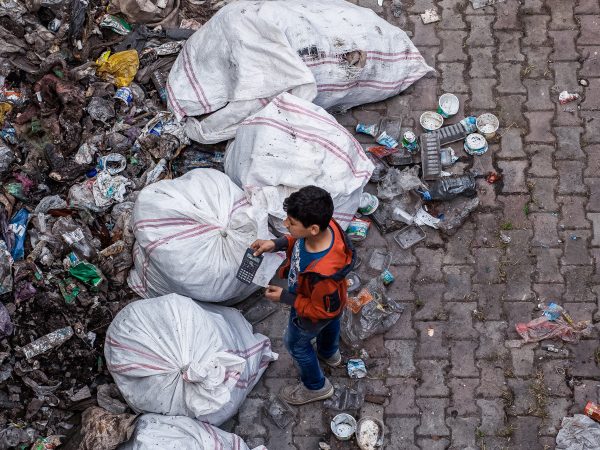One of the world’s top plastic polluters is giving its garbage a second life by using it to construct much-needed infrastructure.
Philippine companies like San Miguel Corp. and Aboitiz Equity Ventures Inc. are using discarded shopping bags, sachet wrappers and plastic packaging to fire cement plants and build roads as the country embarks on an 8 trillion-peso ($157 billion) infrastructure push through 2022.
San Miguel has laid down its first road combining plastic scraps with asphalt, it said in November. The surface material, developed with Dow Chemical Co., used 900 kilograms (1,984 pounds) of plastic to pave a 1,500-square meter (16,145-square foot) test site near the capital.
For Aboitiz’s Republic Cement & Building Materials Inc., plastic serves as an alternative to coal for heating kilns used in making cement. The company is sourcing waste from consumer giants like Nestlé Philippines Inc. and Unilever Philippines Inc. as it processes at least 25,000 tons of plastic annually, director Angela Edralin-Valencia said in an interview.
The two initiatives target soft plastics that are hard to recycle and make up a significant chunk of the trash piling up in Philippine landfills and clogging waterways. Waste management systems have failed to keep up with a growing population and robust consumption in the Southeast Asian nation, which uses 48 million shopping bags and 164 million plastic sachets every day, according to the Global Alliance for Incinerator Alternatives, or GAIA.
It’s a similar story across Asia’s emerging markets, where rising incomes and burgeoning middle classes have spurred greater plastic use. China, Indonesia, Philippines, Thailand and Vietnam are the top sources of plastic waste in the world’s oceans, according to Ocean Conservancy Inc. and McKinsey & Co.
With the Philippine government planning a construction spree of airports, highways, rails, bridges and dams over the next three years, San Miguel and Republic Cement hope to tap the expected spike in activity to make a dent in the country’s plastic problem.
The “Build, Build, Build” program is the centerpiece of President Rodrigo Duterte’s blueprint for the Philippines, one of Asia’s fastest-growing economies. Gross domestic product is expected to grow 6.5%-7.5% a year through the end of 2022, driven by infrastructure spending.
San Miguel, the Philippines’ largest company, is building more than 900 billion pesos worth of the government’s flagship projects, including several toll roads around the capital and a 2,400-hectare complex north of Manila that will be the country’s biggest airport.
According to San Miguel’s initial findings, roads using plastic scraps exceed government standards and are stronger and more durable than those made with conventional asphalt.
Garbage Collection
Republic Cement likewise expects to “comfortably meet” market demand for cement, while using plastic to replace as much as 10% of its coal requirements, Valencia said.
The company could process as much as four times more plastic waste, but limited garbage collection and poor segregation by households and at landfills make it difficult to sift for usable scraps, Valencia said.
Nestlé and Unilever have launched their own collection programs, offering cash and free products like shampoo and laundry detergent — also packaged in sachets — for plastic scraps that are properly cleaned and cut. Both companies aim to collect and process more plastic than they produce, and make 100% of their packaging recyclable, reusable or compostable by 2025, they said in separate statements.
“Nestlé is aiming for plastic neutrality, which is essentially recovering plastics equal to what we produce,” Kais Marzouki, chairman and chief executive officer of the Philippine unit, said in a statement.
Initiatives to address the issue can have unforeseen consequences. Shredding plastic for asphalt and cement production breaks down waste to microplastics that are even more difficult to collect and reuse, said Beau Baconguis, GAIA’s regional plastic campaigner for Asia-Pacific. Feeding plastic into cement kilns releases toxic fumes, she added.
“It’s garbage in, garbage out,” she said.
Republic Cement’s Valencia says plastic-derived fuel involves less carbon emission than coal, while other fumes are subject to regular government monitoring. Unlike incineration, which is banned in the Philippines, the higher temperatures in cement kilns leave behind no plastic ash, Valencia said.
As the Philippines mulls regulations on the import and use of single-use plastic, GAIA’s Baconguis said companies should also rethink how they package and market their products.
“Companies need to create an entire closed-loop system to address the plastic waste they’re generating,” she said. Until then, corporate initiatives are “just a band-aid solution to the problem.”
–from Bloomberg and the SupplyChainBrain
This is amazing. It’s like making floor mats with old tires. I love it. Put the shit to use.–Bandit
